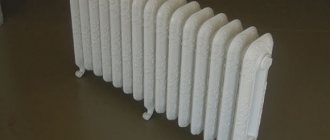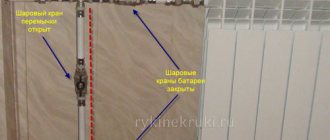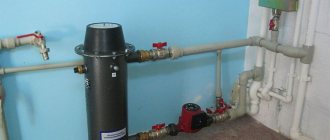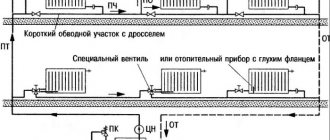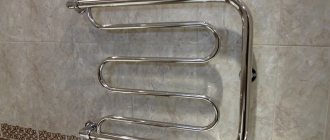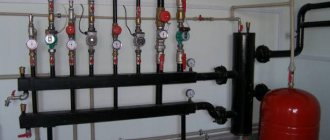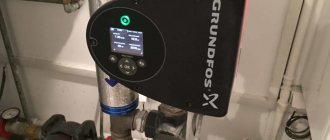The principle of operation of the gravity heating system of a private house
The gravity heating system of a private house is based on two physical principles. The first is that substances have different densities at different temperatures. The second is that the pressure in the system is created due to the difference in the levels of liquid, and the greater the difference between the upper and lower points, the higher the pressure in the system.
The first principle of a gravitational heating system is that when the coolant liquid is heated, and it does not have to be water, it changes its density. Water in its normal state at a temperature of 20 degrees has a density greater than that heated to 45 degrees; when heated to 80 degrees, the difference will be such that additional volume for water will be required. In this case, the coolant of the same mass will occupy a different volume, which is why it begins to expand and is forced out of the heat exchanger. In a confined space, after the heated coolant begins to move, the cooled coolant takes its place. So, under the influence of heating, a flow arises, and the gravitational heating system begins to work.
The second operating principle of this circuit begins to work from the moment the coolant begins to move. As water or antifreeze heats up, the speed of movement increases, since the temperature rises quickly and the expansion of volume forces the liquid to be forced out of the water jacket of the boiler at a higher speed. Leaving the boiler volume, the liquid escapes through a vertical pipe to the expansion tank. Having reached the branch level, the liquid fills the volume of the pipe and rushes along the pressure loop to the pipelines leading to the heating radiators, creating the necessary pressure. Taking into account the difference in heights between the point at which the liquid enters the pressure loop and the lower drain point, the created pressure additionally affects the cold coolant.
Gradually warming up, the system reduces the temperature difference between cold and hot coolant, and thus the speed of fluid movement in the system increases to a maximum and can even reach 1 meter per second.
Why is a pressure loop needed in a gravity heating system?
To make it clear, we can give a simple example with a ball. Let's take a rubber ball, drown it with our hand in a bath of water to a shallow depth, and release it. The ball will fly out of the water, float up, measure the distance at which it flies out. Let's do the experiment again, only we'll drown the ball as deep as possible and let it go in the same way, again we'll measure how much it jumps out. In the second case, the ball will jump higher. The same thing happens with the coolant when it comes to a heating system with gravitational or natural circulation. Hot water is lighter than cold water, which means it will rise. The boiler heats the water, and the higher it rises along the riser from the boiler, and if it is straight and its diameter is not underestimated in comparison with the outlet from the boiler, the more the water can accelerate inside the riser, and therefore create pressure.
The hot water will rush upward and will pull cold water from the return line into the boiler, where it will heat up again. Thus, natural circulation will be realized in the heating system.
The faster and better the circulation, the smaller the difference in supply and return temperatures in the system will be. The water speed with a well-functioning system can reach 1 m/s. From the lowering, the bottling of the future heating system is brewed.
What pipes can be used?
To install the system, you can use not only steel pipes. You can also use polypropylene, copper, stainless steel, etc. The main thing when using polymer pipes is to look at the temperature at which it is permissible to use this pipe. To fill the system, risers are then welded, which serve to connect radiators.
Moreover, bottling in a gravitational system can be on floors and lower ones, which is everyone’s favorite. But for this, a condition must be met: the top of the boiler must be lower horizontally than the bottom of the radiators. That is, the boiler must be in the basement or, as already mentioned, be buried. But nothing prevents you from making a mixed distribution, the first floor with an upper filling, and the second and upper floor with a lower one. Moreover, the lower bottling of the second or other upper floor can be either single-pipe or double-pipe.
Pipe selection
The required profile size for the pipeline is called upon completion of the system design - this is the task of the master. The home owner, in turn, can choose pipes for installation. An option can always be recommended by a design specialist, but you need to understand what parameters a particular material has and how it will affect the operation of the heating. For gravity heating, the following options are used:
- stainless steel profile;
- polypropylene;
- copper.
Polypropylene pipe is considered the best choice. The material weighs little, is easy to install and does not corrode. The last property is especially important since the material will be in constant contact with the liquid. Polypropylene has excellent sound insulation. Typically, the flow of water is not accompanied by loud sounds, but due to the properties of the material, the operation of the system will be absolutely silent.
The main point when installing a polypropylene pipeline is the maximum temperature that the selected pipe can withstand. The reinforcing coating helps the polypropylene pipeline resist thermal deformation. This is a protective layer that neutralizes the effect of hot water on the material.
It is recommended to install the part of the pipeline through which water returns to the boiler from steel. This metal accelerates the cooling of the liquid and reduces hydraulic resistance during operation of the heating system.
Types of heating systems with gravity circulation
Despite the simple design of a water heating system with self-circulation of coolant, there are at least four popular installation schemes. The choice of wiring type depends on the characteristics of the building itself and the expected performance.
To determine which scheme will work, in each individual case it is necessary to perform a hydraulic calculation of the system, take into account the characteristics of the heating unit, calculate the diameter of the pipe, etc. You may need professional help when performing the calculations.
Closed system with gravity circulation
In EU countries, closed systems are the most popular among other solutions. In the Russian Federation, the scheme has not yet received widespread use. The operating principles of a closed-type water heating system with pumpless circulation are as follows:
- When heated, the coolant expands and water is displaced from the heating circuit.
- Under pressure, the liquid enters a closed membrane expansion tank. The design of the container consists of a cavity divided by a membrane into two parts. One half of the tank is filled with gas (most models use nitrogen). The second part remains empty for filling with coolant.
- When the liquid is heated, pressure is created sufficient to push through the membrane and compress the nitrogen. After cooling, the reverse process occurs and the gas squeezes water out of the tank.
Otherwise, closed-type systems work like other heating schemes with natural circulation. The disadvantages include the dependence on the volume of the expansion tank. For rooms with a large heated area, you will need to install a spacious container, which is not always advisable.
Open system with gravity circulation
The open type heating system differs from the previous type only in the design of the expansion tank. This scheme was most often used in old buildings. The advantage of an open system is the ability to independently manufacture a container from scrap materials. The tank usually has modest dimensions and is installed on the roof or under the ceiling of the living room.
The main disadvantage of open structures is the entry of air into pipes and heating radiators, which leads to increased corrosion and rapid failure of heating elements. Airing of the system is also a frequent “guest” in open-type circuits. Therefore, radiators are installed at an angle; Mayevsky valves must be provided to bleed air.
Gravity heating: advantages of a gravity heating system
Before considering the positive qualities of gravity heating systems with natural circulation of water, it is worth separately considering all the disadvantages of the system.
For many, the first and main disadvantage of a gravity heating system is its archaic nature. Indeed, this is one of the most ancient heating systems using liquid coolant. It was from this system that one- and two-pipe wiring diagrams were subsequently developed; it was this system that was used for mass installation when the industry mastered solid fuel heating boilers and, a little later, gas heating boilers. But on the other hand, the gravity heating system is also one of the most reliable - its service life is on average 45-50 years. That is, exactly as long as it takes for the metal pipes to lose their tightness under the influence of the coolant. The second point is the low efficiency of the gravity heating system. Indeed, the scheme itself, based on the natural circulation of water, implies the inertia of the process of heating the room, until the heating boiler gains the necessary power and the temperature difference between the heated and cooled coolant reaches a minimum, quite a lot of time will pass. But on the other hand, even after the boiler stops supporting combustion, the circulation process continues, and a large volume of water in the system will cool much longer than in a system with forced circulation.
Another disadvantage can be attributed to the gravity heating system due to its bulkiness. In practice, with the same area of the heated room, a system with forced circulation compared to a gravity one will take up much less space. In addition to batteries, the gravity heating system will also contain overhead distribution pipes, without which it is impossible to create the required fluid pressure.
And of course, there is the question of temperature control in individual radiators, and the possibility of adjusting it. A gravity heating system in its classic form with a single-pipe construction scheme cannot provide such a function due to the impossibility of shutting off a separate radiator.
But on the other hand, this is an ideal system for installation in homes where there is no electricity or constant problems with its supply. A gravity heating system can operate without electricity, since the main force of coolant movement through the system is not the circulation pump, but the thermal expansion of the coolant volume.
The large volume of coolant in the system allows for smooth heating of the room. On the other hand, such a volume of heated coolant cools much more slowly than the volume of a system with forced circulation. This is especially evident when there is a power outage or the fuel in the furnace goes out. A forced circulation system cools 3-4 times faster than such an archaic gravity heating system.
This property is often used when staying in a house temporarily - simply, instead of ordinary water, antifreeze is poured into the system, and even after complete cooling, neither the pipes nor the radiators are in danger of rupturing due to freezing of water.
And of course, it is simply necessary to note that such a system is simply trouble-free in operation. If it is used correctly, it can last about 50 years, and it has only two risk factors. The first is the threat of boiler overheating, but here too this mainly depends on the human factor, and not on the system. The second is freezing of the coolant, but in this case, the use of antifreeze reduces the risk of this accident to almost zero.
Wiring diagram
The figure shows a simplified installation diagram for a gravity heating system in a private home.
The main elements are:
- heating boiler;
- heating devices (radiators);
- pipes;
- compensation (expansion) tank.
In reality it should look something like this. The boiler is installed at the lowest point of the house in a pre-designed location. A riser is led from it to the highest point. It's better if it's in the attic. The accelerating riser must be connected to a compensation or expansion tank.
If the tank is open, then an overflow pipe is installed on it, which is installed as close as possible to the sewer system. When the tank is made closed, it can be located in the boiler room on the return line (In this design, a safety relief valve is installed). It is necessary to install an air vent on the open tank and release it from it. The filling of the system is welded to the tempering.
Everything, the skeleton, the backbone of the system, is ready. All that remains is to connect the pipes, heating radiators and you're done. We are warming up, but, as they say, “it was smooth on paper...”.
A simplified version of a heating system with natural coolant circulation
The boiler is installed, the place for it is determined in advance. The supply riser is removed from the boiler, and in a predetermined place upward, as far as possible in the building. As a rule, in the attic or some storage room on the top floor of a country house.
An expansion tank with an overflow pipe leading to a utility room where there is a sewerage system is installed at the top of the riser. If the expansion tank is supposed to be closed, then it is installed on the return line in the boiler room or other room, and an auto-ventilator is installed at the highest point. A security group is also installed in the boiler room on the 1st floor. The boiler must be installed as low as possible, in a pit or basement. It is prohibited to install a gas boiler in the basement. From the top point, where the open expansion tank or air vent was installed, a lowering is made. This creates a pressure loop. Next, we’ll talk about why a pressure loop is needed.
Installation
To enlarge, click
When choosing a gravity heating system, the first thing you need to do is design it. Perhaps this is the only moment when it is impossible to do anything with your own hands.
This part of the work must be entrusted to heating engineers. In order for the system to have an aesthetic appearance, it is advisable to involve a designer in the design. When their work is completed, calculations are made, diagrams are drawn, you can proceed directly to installation.
First you need to select the heating pipes. The diameters and lengths are already known from the project, all that remains is to choose the material. It is better to give preference to polypropylene pipes . They have a lot of positive aspects. These include low weight, ease of connection, high anti-corrosion resistance, high noise insulation, and resistance to defrosting.
All of the above parameters are ideal for GSO.
The remaining heating devices are purchased based on capabilities and preferences, according to indicators, without going beyond the scope of the project. When installing the system, preference is given to two-pipe heating systems. This means that during installation it is necessary to make two pipelines - supply and return.
In this case, the supply line (with hot water) is located under the ceiling, and the return line on the floor or in the basement.
If you need to make a warm floor, you will have to make a collector insert. In this case, each circuit of the system can be powered through its own temperature controller, which will create additional convenience, but will also somewhat complicate the system as a whole. The supply manifold is located at the highest point, preferably in the attic. At the same time, you must not forget about its insulation, by the way, like the entire attic.
Now you can begin installing the system. You need to start with a water heating boiler. Maintaining verticality as accurately as possible, a pipe is led from it to the top, which connects to the compensation tank. Immediately it needs to be well insulated. A hot circuit pipe is inserted into the lower third of the tank. It is connected to the wiring.
At the very top of the tank it is necessary to install an overflow pipe connected to the sewer. It will drain excess water in the system.
Next, you need to lay the pipeline to the heating devices (radiators). After completing these works, you can start laying the return line - a line through which cold water will return to the boiler. When all connections are completed, water can be poured into the system. If there is no water leakage from the connection points, the system starts up.
Such a heating system can easily cope with heating a small two-story cottage with all household premises. Thus, of all types of systems, it is advisable to give preference to a two-pipe system.
The essence of the system
How circulation pressure arises
The flow movement of a heat-carrying liquid through pipes is due to the fact that when its temperature decreases and increases, it changes its density and mass.
The temperature of the coolant changes due to heating of the boiler.
The heating pipes contain a colder liquid, which has given up its heat to the radiators, so its density and mass are greater. Under the influence of gravitational forces in the radiator, the cold coolant is replaced by hot one .
In other words, having reached the top point, hot water (this can also be antifreeze) begins to be evenly distributed over the radiators, displacing cold water from them. The cooled liquid begins to sink into the lower part of the battery, after which it completely goes through the pipes into the boiler (it is displaced by the hot water coming from the boiler).
As soon as the hot coolant enters the radiator, the process of heat transfer begins. The walls of the radiator gradually heat up and then transfer the heat into the room itself.
The coolant will circulate in the system as long as the boiler is operating.
Add-ons to improve system efficiency
The heating installation can perform better if improvements are made to the design. These measures optimize the system, increase efficiency and smooth out deficiencies that may affect the quality of operation. The following additions can be suggested:
- Installation of a reverse trap that blocks accidental movement of liquid in the wrong direction.
- Mounting the circulation pump. Installing this add-on reduces the inertia of the gravitational system. If the heating time is exceeded, this improvement increases the speed of water flow. As a result, the liquid is heated to the required level.
- Highway slope. Allows you to obtain the optimal pressure level during system operation.
Gravity heating in the basic configuration will work without additional measures, but installing auxiliary elements will significantly increase efficiency and reduce the likelihood of breakdowns. To make changes, they are discussed in advance with the heating engineer responsible for the project.
Recommendations for this system
To improve the existing scheme, experts can suggest the following measures to increase efficiency:
- Pump installation. It is circulating and is installed on the bypass. Its purpose is to reduce the inertia of the system. If the heating time is exceeded, the pump will help increase the speed of water through the pipes to obtain the required temperature;
- Main slope - to achieve optimal pressure in the gravity heating system.
- Reduced bends along the entire length of the pipeline. This helps reduce the risk of reducing the speed of water along the main line.
- Installation of a reverse trap. It will prevent the possibility of water moving in the opposite direction.
Underfloor heating
To make the floor warm, you will need a collector cutout. Each circuit is connected through an individual temperature controller. This will complicate the design of the system as a whole, but will create additional comfort. In this case, you need to install the supply manifold in the attic, since there is the highest point of the house, if the attic is not insulated, be sure to do it. All these measures are taken before installing the entire system.
Advantages and disadvantages of a gravity heating system
To summarize, we list the main advantages that the gravity system has:
- Reliability (since the system is made of high-strength metal and other reliable materials, repair work will have to wait a very long time, since there are no elements that are subject to rapid deterioration);
- No dependence on energy supply;
- No noise or vibration;
- Easy to use.
It would seem that there are no disadvantages at all, but they are there, although not significant:
- At first glance, the whole system is quite simple, but this does not apply to the financial investment for its acquisition. The amount will be quite large;
- Some wiring diagrams assume a large temperature difference between batteries;
- If the circulation rate is low, there is a possibility that the expansion tank and part of the system located in the attic will freeze, therefore, we previously talked about its insulation.
- When the system is started for the first time, heating of all radiators located throughout the entire circuit will take several hours.
Installation recommendations
Pipe slope in a gravity heating system
Having completed the calculation for a gravity heating system made of polypropylene or steel pipes, you can begin installing it. To achieve optimal efficiency, experts recommend making small but important changes to the standard circuit:
- Highway slope . The optimal gravitational pressure for the heating system can be achieved by sloping the pipes after the air vent and on the return line behind the last heating device;
- Installing a circulation pump on the bypass . It will help reduce the inertia of the system. The heating time of the coolant can be very long, so the pump can increase the speed of its movement along the line until the desired temperature is reached;
- Minimum of turning units in the pipeline . They create excess hydraulic resistance, which reduces the speed of water movement;
- Installation of protective elements . By installing a check valve for gravity heating, you can prevent water from circulating in the wrong direction. This is especially necessary for a system with overhead wiring and multiple circuits.
The main components of a properly made pressure gravity heating system are a professionally made preliminary calculation, selection of the right materials and adherence to installation technology. This will make it possible to create an effective system for maintaining a comfortable temperature in the house.
Tips on arranging and using a gravity valve for heating when installing heated floors and additional elements can be seen in the video:
The principle of coolant circulation in the system
If we talk about apartment buildings, then in such buildings the circulation of water in the heating system is determined by the pressure difference formed between the inlet and outlet pipelines.
It is absolutely logical that if the pressure in one pipe exceeds the pressure in another, this will inevitably force the water in the circuit to move (read: “Losses and pressure drop in the heating system - solving the problem”). However, with private houses the situation is different. In these buildings, heating systems very often operate in autonomous mode, and the main source of energy in such systems is usually electricity, sometimes solid fuels. This option provides for the movement of water, which is carried out through the operation of a heating circulation pump equipped with an electric motor with a small power of 100 W.
But the use of such modern equipment cannot always be afforded; in addition, such mechanisms appeared on the construction market relatively recently.
Previously, the main type of heat supply was a gravity heating system, the diagram of which shows in detail the entire process of coolant circulation. In this case, the movement of water occurred naturally. In this case, we are talking about such a physical phenomenon as convection, when the density of the heated material decreases, and other, heavier substances take its place. If this entire process burns in a confined space, then the heated material rises to the top point.
In order to use such a working mechanism effectively, it is necessary to equip a special circuit with an appropriate shape, and thanks to the principle of convection, the coolant will move in a circle continuously.
In simpler terms, the diagram of a gravitational heating system consists of two communicating vessels, which are connected to each other in a ring through tubes, or a heating circuit. The first of these vessels is the boiler, and the second represents the heating device used.
It is important to remember that the height of a heating boiler, which is equipped with an accelerating manifold for heating radiators, is directly proportional to the speed of the coolant moving inside the circuit.
The water heated by the boiler flows upward, and is replaced by colder water coming from the battery, where it is gradually heated. Then the newly heated coolant again moves to the radiator, and the already cooled one comes in its place. This is precisely the essence of natural circulation, since these cycles are endless and do not require any human intervention.
In order for such a closed gravity heating system to have a high coolant circulation rate, it is worth taking into account the following points:
- the heating boiler needs to be placed as low as possible relative to the heating appliances, and if there is a basement, it would be better to install it there;
- The height of the accelerating manifold can be different; this mechanism can be located either directly under the ceiling or even higher, for example, in the attic. The expansion heating tank should be installed in the same place (read also: “Collector heating system of a private house - wiring diagram”);
- Improving water circulation will also be possible by installing a certain slope from the tank to the boiler, since the optimal design of a gravity heating system provides for the movement of cooled water precisely according to this principle.
We should also not forget that what the circulation rate of the coolant in the system will be is influenced by two parameters: this is the difference inside the circuit, as well as the indicator of hydraulic resistance (about
Differences in the operation of a solid fuel boiler
The heart of any heating system is the boiler. Although the same models can be installed, operation with different types of heating will differ. For normal operation of the boiler, the temperature of the water jacket must be at least 55 °C. If the temperature is lower, then the inside of the boiler will be covered with tar and soot, as a result of which its efficiency will decrease. It will need to be constantly cleaned.
To prevent this from happening, a three-way valve is installed in a closed system at the boiler outlet, which circulates the coolant in a small circle, bypassing the heating devices, until the boiler heats up. If the temperature begins to exceed 55 °C, then the valve opens and water begins to flow into the large circle.
A three-way valve is not required for a gravity heating system. The fact is that here the circulation occurs not due to the pump, but due to the heating of the water, and until it heats up to a high temperature, movement does not begin. In this case, the boiler furnace remains constantly clean. A three-way valve is not required, which reduces the cost and simplicity of the system and adds to its advantages.
Operating principle of GSO
A gravity heating system is nothing more than a heating system with natural circulation of coolant.
In other words, the water that heats the home moves through the pipes by gravity. It is easy to install and does not require the installation of expensive equipment.
The water heated in the boiler flows through the riser to the heating devices, gives off heat to them, and when it has cooled down it returns to the boiler. Since the density and mass of cooled water is greater, it displaces hot water from the boiler into the system. The process of coolant movement in the pipes is repeated. This will happen as long as the heater – the boiler – is working.
Water circulates in the system independently, without the participation of a pump . The only drawback of this system is low circulation pressure, but this drawback can be successfully combated. We will talk about this in more detail in this article.
Heating safety
As mentioned above, the pressure in a closed system is greater than in a gravitational one. Therefore, they take a different approach to security. In closed heating, the expansion of the coolant is compensated in an expansion tank with a membrane.
It is completely sealed and adjustable. After the maximum permissible pressure in the system is exceeded, the excess coolant, overcoming the resistance of the membrane, goes into the tank.
Gravity heating is called open due to a leaky expansion tank. You can install a membrane-type tank and make a closed gravity heating system, but its efficiency will be much lower because the hydraulic resistance will increase.
The volume of the expansion tank depends on the amount of water. To calculate, its volume is taken and multiplied by the expansion coefficient, which depends on temperature. Add 30% to the result obtained.
The coefficient is selected according to the maximum temperature that the water reaches.
Features of design and installation
The main components of the gravitational system include:
- heating boiler in which water or antifreeze is heated;
- pipeline (double or single);
- heating batteries;
- expansion tank.
When designing, as well as directly during installation of the system, it is very important to meet one mandatory condition : the pipe through which the coolant will move must be sloping towards the heating boiler. The slope must be at least 0.005 m per linear meter of pipe.
In general, if the boiler and radiator are located on the same floor, then the pipe entrance to the radiator should be slightly higher.
Scheme of a gravity system with pipe slope
The presence of this bias is explained by the following factors:
- through an inclined pipe, cold coolant will flow faster into the boiler;
- the presence of a slope is also necessary so that the air bubbles that appear during the heating process of the coolant rise more efficiently into the expansion tank, from which they evaporate into the atmosphere.
The expansion tank creates additional pressure , which has a beneficial effect on the speed of water movement through the pipes.
The speed of movement of the working fluid directly depends on the difference in such quantities as mass, density and volume of the coolant in cold and hot states. The speed of flow movement is also affected by the level of radiators relative to the boiler.
The gravitational pressure in the heating system is used to some extent to overcome the resistance of the pipeline. Additional obstacles include turns and branches in the system, and additional radiators.
Therefore, in order to maximize room heating, when designing a gravity system, you need to ensure that there are as few such obstacles as possible.
Air locks and how to deal with them
For normal heating operation, the system must be completely filled with coolant. The presence of air is strictly prohibited. It can create a plug that prevents water from passing through. In this case, the temperature of the boiler water jacket will differ greatly from the temperature of the heating devices. To remove air, air valves and Mayevsky taps are installed. They are installed at the top of heating devices, as well as in the upper sections of the system.
However, if gravity heating has the correct slopes for the supply and return pipes, then no valves are required. The air in the inclined pipeline will freely rise to the top point of the system, and there, as you know, there is an open expansion tank. This also adds to the benefit of open heating by reducing unnecessary elements.
Is it possible to install a system made of polypropylene pipes?
People who do their own heating often wonder whether it is possible to make a gravity heating system from polypropylene. After all, plastic pipes are easier to install. There is no expensive welding or steel pipes, and polypropylene can withstand high temperatures. You can answer that such heating will work. At least for a while. Then efficiency will begin to decline. What is the reason? The point is the slopes of the supply and discharge pipes, which ensure gravity flow of water.
Polypropylene has greater linear expansion than steel pipe. After repeated heating cycles with hot water, plastic pipes will begin to sag, disrupting the required slope. As a result, the flow rate, if it does not stop, will decrease significantly, and you will have to think about installing a circulation pump.
What is the diameter of the pipe for gravity heating
Gravity heating made of polypropylene pipe
It may seem to many people that since polypropylene has low thermal conductivity, 200 times less than steel, then such a pipe will give off very little heat. However, it is not. The difference in heat transfer from polypropylene is 15 - 30% less than that of a steel pipe. Depends on the diameter. The larger the diameter, the greater the difference.
Below are tables showing the heat transfer from the pipeline. Suitable for understanding how much thermal energy is released in a heated room.
Heat transfer from steel pipe
Heat transfer from polypropylene pipe
The difference in heat transfer from polypropylene is 15 - 30% less than that of a steel pipe. Let's figure out why the difference is so small.
To understand this, let’s look a little at the theory of heat transfer.
Heat transfer from the pipe to the atmosphere occurs only from the surface of the pipe, and not from the depth of the pipe or anywhere else. Heat leaves the pipe surface in two ways: Radioactive radiation and convective heat transfer.
Radioactive radiation
- these are not only terrible waves that kill people. Radioactive waves can be safe in some wavelength range. For example, those that transmit heat through direct beams.
Convective heat transfer
- This is direct contact of air with the surface of the pipe. The air, heating up from the pipe, expands, becomes lighter, and rises, freeing up space for another portion of air. The air constantly washes the surface of the pipe, thereby removing heat from the surface of the pipe.
The power of heat transfer from the surface of the pipe has its limit. That is, heat transfer to the atmosphere occurs with some degree of resistance. The air that envelops the surface also serves as thermal resistance. Thermal energy also escapes poorly through thermal radiation.
Therefore, when transferring heat to the atmosphere, not only the thermal conductivity of the pipe material is taken into account, but also thermal radiation and convection.
The heat transfer resistance of the pipe walls is not so high compared to the thermal and convective resistance. Therefore, the thermal conductivity of polypropylene is not so small as to greatly affect heat transfer.
And it is useless to increase the thermal conductivity of a steel pipe in order to improve heat transfer. That is, if you install a pipeline with a thermal conductivity twice as high as steel, this will not double the heat transfer to the surface.
No matter how much we increase the thermal conductivity of the pipe wall, even to infinity the increase in heat transfer will be a negligible value.
The surface itself can influence the resistance to thermal radiation. For example, a black surface transmits thermal radiation better than a white surface. Paints on radiators have increased thermal radiation properties.
The fact that even a polypropylene pipe gives heat transfer from the pipe is a plus in favor of the polypropylene pipe. Polypropylene pipe can be used as register heating. That is, a polypropylene pipe can be a source of heat transfer.
If the pipeline can give off heat, then this increases the gravitational pressure. Or there is also such a thing as an accelerating loop / collector or pipe in the GSO. A polypropylene pipe can be used as an accelerating loop.
Why is polypropylene pipe rarely used for gravity heating systems?
Of course, it can be used, but very carefully. I will try to tell you all the nuances about the polypropylene pipeline.
Plumbers, including myself, have thoughts that polypropylene pipes do not like high temperatures. The cat says that you can’t exceed 75 degrees, someone says 80 degrees. Pipe manufacturers claim that polypropylene pipe will work fine up to 90 degrees. But, in any case, there is one undeniable argument: the higher the temperature, the shorter the service life of this pipe. It will crack or burst faster, and there will be leaks. It is difficult to predict the service life of a pipe.
Very often, a gravity heating system is used with a (TTK) Solid Fuel Boiler. And the TTK can produce high temperatures above 90 degrees. Therefore, a polypropylene pipeline can be used for a gravity heating system, but very carefully. How you can protect polypropylene from high temperatures is to buy a TTK with a lower power that is half the maximum heat loss at home. It is better to buy two heating systems for 50% of the maximum heat loss of the house. Well, if you use TA, then a special calculation is needed; in this case, the power of TA can be twice as large as the maximum heat loss of the house.
Polypropylene pipes tend to elongate, but this can be combated by using reserves for pipe elongation. The pipes really grow, and then it looks terrible! As the pipes lengthen, waves – bends – may appear. In order to have fewer waves, you will have to frequently install brackets and try to make sliding brackets. That is, when the pipe is extended, it must move along the brackets.
They also write on the Internet that polypropylene pipes generate noise and release harmful substances into the air we breathe. They write that the maximum temperature for them is up to 75 degrees, so that they last for 30 years. As the temperature rises, harmful substances are released even more. Also, GSO requires large diameters, which means that harmful emissions will be even greater.
Difficulties in installing a gravity system in a two-story house
A gravity heating system for a two-story home can also work efficiently. But its installation is much more complicated than for a one-story one. This is due to the fact that attic-type roofs are not always made. If the second floor is an attic, then the question arises: where to put the expansion tank, because it should be at the very top?
The second problem that you will have to face is that the windows of the first and second floors are not always on the same axis, therefore, it is impossible to connect the upper batteries with the lower ones by laying pipes along the shortest route. This means that you will have to make additional turns and bends, which will increase the hydraulic resistance in the system.
The third problem is the curvature of the roof, which may make it difficult to maintain proper slopes.
Advantages and disadvantages
Although the natural heating system is very popular, it is not without certain disadvantages.
First of all, this is the limited length of the pipeline .
A long pipeline is not able to distribute fluid pressure evenly throughout the entire system, so the maximum permissible horizontal length is 30 meters. It makes no sense to exceed this figure, since the greater the distance between the boiler and the pipe, the less pressure there is.
Also among the disadvantages of the system with EC is the high cost of installation .
According to experts, the cost of installing a gravity heating system is about 7% of the cost of building the house itself. This is due to the purchase of large diameter pipes, which are necessary to create the required pressure for a large volume of coolant.
Another negative quality: slow heating of heating radiators .
READ ALSO: Description of a heating system with forced circulation of coolant
But such a system also has many advantages.
A natural circulation system is the most reliable type of autonomous heating in terms of quantitative self-regulation .
Gravity heating system for a two-story house
When the temperature of the working fluid changes, its flow rate also changes.
The more coolant in the system, the higher the heat transfer of radiators. This indicator also interacts with the heat loss of the room in which they are installed. The greater the heat loss of the room, the higher the heat transfer.
This is called self-regulation.
Other advantages of the gravity system:
- ease of installation and operation;
- absence of a circulation pump, which means complete energy independence;
- long service life - about 40 years;
- high reliability.
Advantages and disadvantages of GSO
Gravity heating systems are becoming increasingly popular when heating small one- or two-story country houses.
It has become widespread due to a number of advantages unique to it.
First of all, these include:
- high efficiency;
- reliability;
- ease of maintenance and repair.
The savings from such a heating system are evident even at the preparatory stage. There are no booster pumps in the system. The savings on the purchase of pumps and the electricity they consume are obvious. The system itself is very simple in design, which means that expensive repairs will bypass it. These two aspects will already provide significant savings.
Movement of cooled coolant
One of the misconceptions is that in a system with natural circulation, the cooled coolant cannot move upward.
I don't agree with this either. For a circulation system, the concept of top and bottom is very arbitrary. In practice, if the return pipeline rises in some section, then somewhere it falls to the same height. In this case, gravitational forces are balanced.
The only difficulty is in overcoming local resistance at turns and linear sections of the pipeline. All this, as well as possible cooling of the coolant in the lifting sections, must be taken into account in the calculations. If the system is correctly calculated, then the diagram presented in the figure below has a right to exist. By the way, at the beginning of the last century such schemes were widely used, despite their weak hydraulic stability.
Radiator location
They say that with natural circulation of the coolant, radiators must be located above the boiler.
This statement is true only when the heating devices are located in one tier. If there are two or more tiers, the radiators of the lower tier can be located below the boiler, which must be checked by hydraulic calculations.
Specifically, for the example shown in the figure below, with H = 7 m, h1 = 3 m, h2 = 8 m, the effective circulation pressure will be:
g = 9.9 [ 7 (977 – 965) – 3 (973 – 965) – 6 (977 – 973)] = 352.8 Pa.
Here:
ρ1 = 965 kg/m3 – density of water at 90 °C;
ρ2 = 977 kg/m3 – density of water at 70 °C;
ρ3 = 973 kg/m3 – density of water at 80 °C.
The resulting circulation pressure is sufficient for the operation of the above system.
Gravity heating - replacing water with antifreeze
I read somewhere that gravity heating, designed for water, can be painlessly converted to antifreeze. I would like to warn you against such actions, since without proper calculation, such a replacement can lead to a complete failure of the heating system. The fact is that glycol-based solutions have a significantly higher viscosity than water. In addition, the specific heat capacity of these liquids is lower than that of water, which will require, other things being equal, an increase in the coolant circulation rate. These circumstances significantly increase the calculated hydraulic resistance of a system filled with coolants with a low freezing point.
Using an open expansion tank
Practice shows that coolant must be constantly added to an open expansion tank, as it evaporates.
I agree that this is a really big inconvenience, but it can be easily eliminated. To do this, you can use an air pipe and a hydraulic valve installed closer to the lowest point of the system, next to the boiler. This tube serves as an air damper between the hydraulic seal and the coolant level in the tank. Therefore, the larger its diameter, the less will be the level of level fluctuations in the water seal tank. Particularly advanced craftsmen manage to pump nitrogen or inert gases into the air tube, thereby protecting the system from air penetration.
Using a circulation pump in gravity heating
In a conversation with one installer, I heard that a pump installed on the bypass of the main riser cannot create a circulation effect, since the installation of shut-off valves on the main riser between the boiler and the expansion tank is prohibited.
Therefore, you can install the pump on the return line bypass, and install a ball valve between the pump taps. This solution is not very convenient, since each time before turning on the pump you must remember to turn off the tap, and after turning off the pump, open it. In this case, installing a check valve is impossible due to its significant hydraulic resistance. To get out of this situation, craftsmen are trying to convert the check valve into a normally open one.
Such “upgraded” valves will create sound effects in the system due to constant “squelching” with a period proportional to the speed of the coolant. I can offer another solution. A float check valve for gravity systems is installed on the main riser between the bypass taps. The valve float is open in natural circulation mode and does not interfere with the movement of the coolant. When the pump is turned on on the bypass, the valve closes the main riser, directing the entire flow through the bypass with the pump.
In this article, I have not considered all the misconceptions that exist among specialists who install gravity heating. If you liked the article, I’m ready to continue it with answers to your questions.

